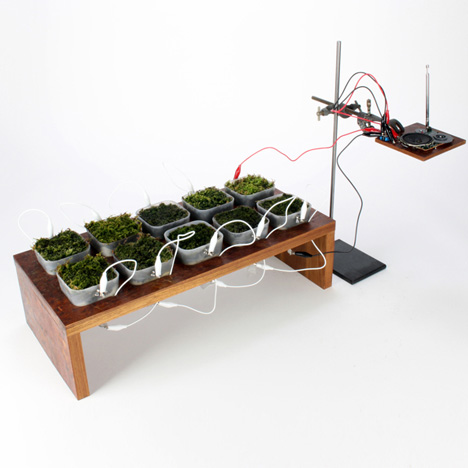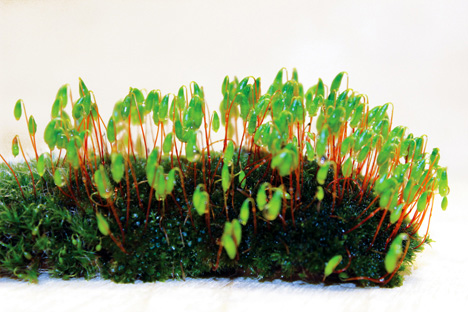
Moss used as "biological solar panels" to power a radio
Swiss designer Fabienne Felder has worked with University of Cambridge scientists Paolo Bombelli and Ross Dennis to develop a way of using plants as "biological solar panels".

"Theoretically any photosynthesising plant could be used as a biological solar panel", said the team, which has developed what it calls Photo Microbial Fuel Cells (Photo-MFCs) to capture and harness the electrical power of plants.

The team has prototyped the world's first moss-powered radio to illustrate the potential of its Photo-MFCs. Moss was chosen because its photosynthetic process makes the plants particularly efficient at generating electricity.
Fabienne Felder developed the technology with biochemist Dr. Paolo Bombelli and plant scientist Ross Dennis, both of the University of Cambridge.
The radio is the first time Photo-MFCs have been used to run an object demanding more power than an LCD screen.

The Photo-MFCs consist of an anode where the electrons generated by photosynthesis are collected, a cathode where the electrons are finally consumed, and an external circuit connecting the anode to the cathode.
The moss grows on top of a composite of water-retaining materials, conductive materials, and biological matter.

The team has high hopes for the potential of this emergent technology. "We may assume that in five to ten years the technology is applicable in a commercially viable form," they said. Currently the technology used in the radio can only capture about 0.1% of the electrons the mosses produce.

Felder compares the technology behind biological solar panels to the very early days of experiments with photovoltaics. "Biological solar panels will go through a similar development phase: determining optimal conductive materials; the right plants; and watering and maintenance systems that guarantee stable flow of electricity", she explained.

"Finding the right plants will be a study in itself," said Felder. "Mosses are extremely desiccation resistant, but they don’t like direct sunlight. Other plants, which might also fulfil certain criteria in their photosynthetic process to be considered efficient photo-active components, might struggle in colder weather. So the right mix of vegetation will be the solution."
Rice paddy fields may also provide good environments for biological solar panels because of the large amount of water used in their cultivation, she added.
Here's some more information from the team:
Moss FM
Moss FM is the World’s first plant-powered radio.
This is made possible thanks to Photo Microbial Fuel Cells (Photo-MFCs), which harness and convert electrons produced by plants during photosynthesis. Moss tufts are essentially used as biological solar panels in this emerging biophilic technology.
The radio was conceived and built by Fabienne Felder, a creative strategist and designer originally from Switzerland, in collaboration with the biochemist Dr. Paolo Bombelli and plant scientist Ross Dennis of the University of Cambridge.
Background
Dr. Bombelli has been working on Photo-MFCs for years – ever since he was inspired by a single sentence in a biochemistry textbook. These studies are now housed at the University of Cambridge and Dr. Bombelli is leading the research as a senior research associate in Prof. Chris Howe's team.
In 2011, a collaboration with two designers, Alex Driver and Carlos Peralta, led to the first conceptual piece to showcase the technology, entitled the Moss Table.
It was also the Moss Table that first got Fabienne Felder interested and she was soon hooked, immersing herself in papers and reports published by Dr. Bombelli and his colleagues. As fate would have it, the two eventually met and Fabienne Felder presented another futuristic scenario in which Photo-MFCs might be applied. Dr. Bombelli needed convincing of the idea that aircraft cabins might one day be moss- clad, but being a scientist, the research eventually won him over and he was keen to get another collaboration started.
From aircraft to air time
The team initially began working on the premise of creating a mossy electricity- generating surface, which might indeed be used to cover aircraft cabins or other spaces in the future. A number of factors eventually shifted the focus of the project to trying to conceive an every-day object that would work today, not in 10 years’ time.
The very thing that motivated the collaborators also kept posing the biggest challenge: feasibility. It was the first time this technology was supposed to work in an object that was not as low-powered as something like an LCD screen. Flexibility was required of the designer, who wanted to respect scientific requirements, and the scientist, who sometimes had to ditch logic for reality. The result is a radio that certainly causes intrigue.
Design and performance
Whereas theoretically any photosynthesising plant could be used as a biological solar panel, the genus of bryophytes can operate as potentially better photo-active components in Photo-MFCs due to particularities in their photosynthetic process. Simultaneously, mosses also quite simply deserve good press and are consciously promoted by the team for their incredible uses and undervalued beauty. Many of those properties are explained on the project blog mosspower.tumblr.com

Moss FM consists of ten Photo-MFCs, which are embedded in a minimalist design taking strong visual cues from the world of biochemistry. They can be connected in series, parallel, or a combination thereof, depending on the performance of each cell. Gadgets such as LCD screens can run continuously connected directly to the circuit, whereas higher consumption objects are bridged via a capacitor or battery solely charged by the Photo-MFCs.
At the moment we can achieve the following electrical output: The current radio run time via a re-chargeable battery lasts a few minutes.
A serial circuit consisting of 5 Photo-MFCs has reached a peak power of ca. 3.5mW per square meter (2.9mA @ 1200mV). A parallel circuit consisting of 5 Photo-MFCs has reached a peak power of ca. 4.6mW per square meter (18.7mA @ 246mV).
What does it all mean?
As with every emerging technology, many questions are as yet unanswered. We may assume that in five to ten years the technology is applicable in a commercially viable form, mainly in emerging economies. But to give an idea of what kind of contributions this low-carbon technology could make, consider this:
If 25% of Londoners (ca. 2.7 million people) charged their mobile phone on average for 2 hours every other day with moss, we would save enough electricity to power a small town: 42.5 million kWh, amounting to a saving of £6.81 Million and 39632 Tons of CO2* a year.
These are interesting values, given the huge amounts of electricity that are wasted during generation and transmission, for example. And even more interesting, if we consider that at the moment we capture only about 0.1% of the electrons the mosses potentially produce.

*Figures based on input and output values of a Nokia charger consuming 180mA
@240V, 2012 N-Power electricity rates, and 2013 UK electricity consumption figures.